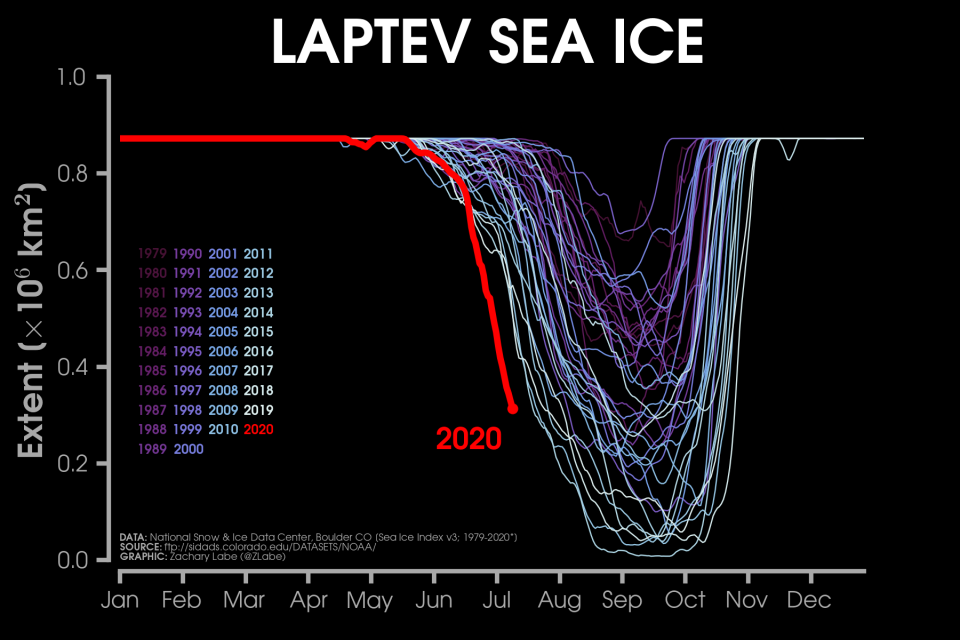The hidden crisis of 2020: Graph reveals 'brutal' climate event
With the world’s attention on the coronavirus pandemic, another potential catastrophe has been quietly reaching new heights.
It’s happening out of sight of most people and taking place at a much slower pace, but scientists are sounding the alarm about what’s been happening in the Arctic in recent months.
Described as the Arctic’s own “brutal” summer of discontent, a heatwave in Siberia and unusually high temperatures have seen record falls in sea ice and an acceleration in the melting of the important Arctic permafrost.
Dr Zachery Labe is a climate scientist at Colorado State University and has been charting the change in sea ice around Siberia during the unusually warm temperatures this year.
“Arctic temperatures are rising more than three times as fast as the globally-averaged mean temperature,” he told Yahoo News Australia.
“This rapid rate of change is accompanied by significant losses of sea ice and snow cover, ocean warming, thawing permafrost, and an increasing frequency of extreme events.”

The warming temperatures are not only affecting local indigenous communities in the Arctic, as well as coastal communities in Alaska, but could also carry global implications.
Arctic hits highest temperature ever recorded
An unsettling milestone made headlines around the world just a few weeks ago. For the first time in recorded history, temperatures reached 38°C in a remote Siberian town of Verkhoyansk, about 4,800 kms east of Moscow. That’s 18 degrees warmer than the maximum daily average for June in that part of the world, and the all-time temperature record for the region.
Pending final verification, it would stand as the highest temperature in the Arctic since record-keeping began in 1885.
The disturbing impact coronavirus is having on our environment
'This is horrible': Video shows riverbank littered with dead fish
The reason the Arctic is warming at a rate much higher than the rest of the planet is believed to be caused by something called Arctic amplification, or Polar amplification.
The bright, white ice caps reflect the sun’s heat, but as the ice cover recedes the heat becomes absorbed by the darker open water left behind which speeds up the melting process and keeps new ice from forming.
Despite this process, some scientists have still expressed amazement at the rate of ice melting this year.
“We always expected the Arctic to change faster than the rest of the globe,” Walt Meier, a senior research scientist at the National Snow and Ice Data Center at the University of Colorado told the Washington Post last week.
“But I don’t think anyone expected the changes to happen as fast as we are seeing them happen.”
The extreme event near Siberia continues to unfold - summer 2020 is already a memorable year in the #Arctic... pic.twitter.com/HbRFoG0LRh
— Zack Labe (@ZLabe) July 14, 2020
Dr Labe says the trend in disappearing ice is clear and it will take a reduction in greenhouse gases to halt the rapidly warming Arctic.
“While every year will not feature record low sea ice, due to natural variability and changing weather, we can expect to see the long-term trends of rising temperatures and declining sea ice levels over at least the next several decades,” he told Yahoo News Australia.
Arctic warming impacting global climates
Scientists are still working to determine the overall impact the Arctic melt will have on weather systems and extreme weather events in more mid-latitudinal countries.
“While nearly a decade of research has tried to address these questions, we still don't understand how Arctic amplification is affecting weather in lower latitudes, especially in our present-day observations,” Dr Labe said.
Given the work that’s being done, it’s a relationship that will become clearer in the future, he explained.

As for countries like Australia – which is already dealing with the deadly effects of a warming planet – Dr Labe says it’s not out of the question the continent could see an impact on its climate due to Arctic amplification.
“Australia is more directly impacted by the Antarctic,” he said. “Interestingly, trends in Antarctic sea ice are quite different from the Arctic due to natural variability and the different geography of the Antarctic continent and surrounding Southern Ocean.”
However, he pointed to recent research that has suggested Arctic sea ice loss can cause accelerated warming around the equator and impact thunderstorms and rainfall across the tropical regions.
The Arctic warming is getting a lot of attention this week, but I keep seeing references to the warming being twice as fast as the global mean, and that's not right.
It's more like 3 times the global mean. pic.twitter.com/n87VwaoQav— Gavin Schmidt (@ClimateOfGavin) June 26, 2020
While the ongoing consequences will continue to slowly reveal themselves, for researchers like Dr Labe, the trend of warming continues to march in an undeniable and concerning direction.
New data released overnight by the National Oceanic and Atmospheric Administration in the US confirmed humans have just lived through Earth's second-warmest January through June on record.
Global temperatures for the first half of 2020 nearly broke a 141-year record that was set in 2016, according to the latest data.
Do you have a story tip? Email: newsroomau@yahoonews.com.
You can also follow us on Facebook, Instagram and Twitter and download the Yahoo News app from the App Store or Google Play.




